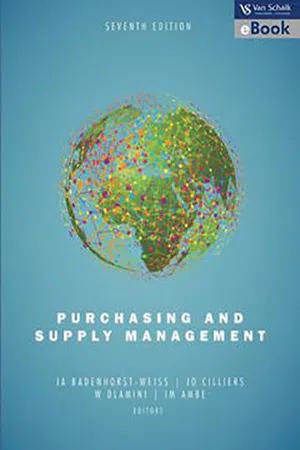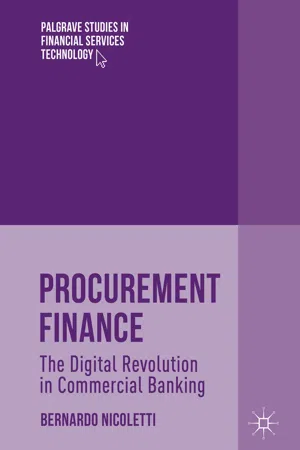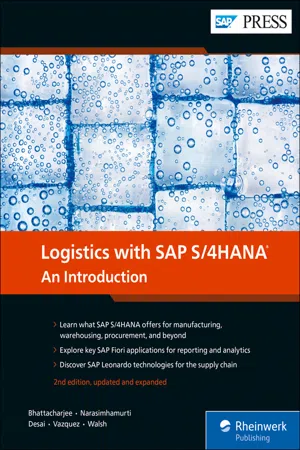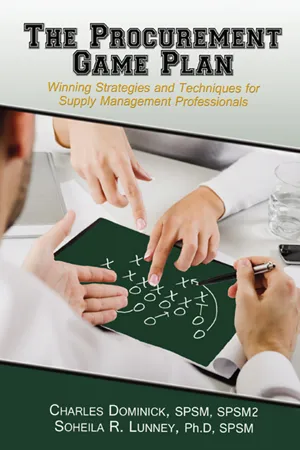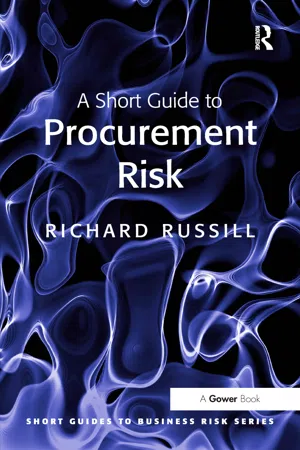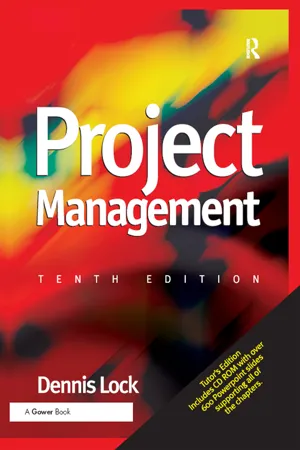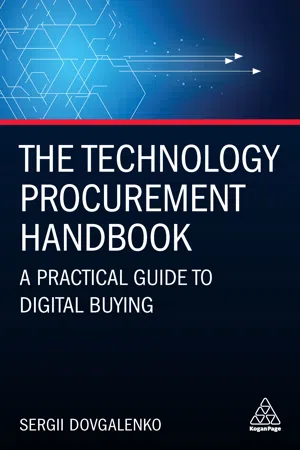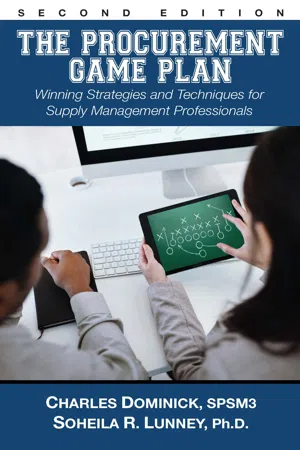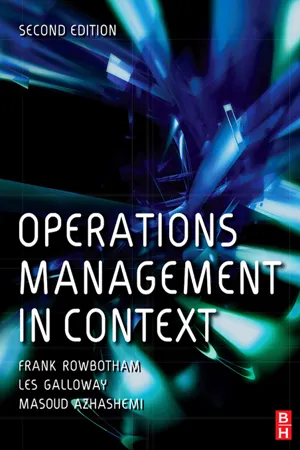Business
Procurement
Procurement refers to the process of acquiring goods, services, or works from an external source. It involves activities such as sourcing, negotiation, purchasing, and contract management. The goal of procurement is to obtain the necessary resources at the best possible value in terms of cost, quality, and delivery.
Written by Perlego with AI-assistance
12 Key excerpts on "Procurement"
- eBook - ePub
- Badenhorst-Weiss JA, Cilliers JO, Dlamini W, Ambe IM(Authors)
- 2018(Publication Date)
- Van Schaik Publishers(Publisher)
Purchasing can have a short-term transactional approach to buying standard, often-used products or services. However, purchasing also has a strategic focus, one that takes the long-term goals of the organisation as a whole into consideration in decisions, and thereby, in a very real sense, contributes to the future direction that the organisation will take.Purchasing and Procurement are often used interchangeably. However, there is a distinction, albeit academic. According to Boateng (2016: 439), Procurement represents purchasing in the wider and more modern concept of supply chain management, and he defines it as “one of the elements of supply chain management primarily focusing on the sourcing and purchasing of goods and services within the supply value chain”.Procurement refers to the process of managing a broad range of activities that are associated with satisfying the organisation’s need for goods and services to keep the organisation going, for example parts or raw materials for the production process; thus, it focuses on the more strategic products and services.What, then, is sourcing? Boateng’s (2016: 513) definition of it as “the process of identifying, conducting negotiations with and forming supply agreements with suppliers of goods and services” makes it clear that sourcing represents the activity of purchasing in the wider and more modern concepts of supply management and supply chain management. These concepts will be explored further later in this chapter.The term strategic sourcing is also often used in purchasing and supply chain management circles. The strategic sourcing process is broader and more comprehensive than the Procurement process. It is a result of the strategic development of the purchasing function in an 5 organisation that is managed according to the modern, integrated supply chain management approach. The principle of this approach will be explored in Chapter 4 .There are different views on what is meant by “strategic sourcing”. One view is that it is the application of certain supply strategies (Wisner, Tan & Leong, 2016: 105): - eBook - ePub
Procurement Finance
The Digital Revolution in Commercial Banking
- Bernardo Nicoletti(Author)
- 2018(Publication Date)
- Palgrave Macmillan(Publisher)
vendor rating process.Procurement
Procurement includes all processes able to ensure that the products and services are available for the customer according to the agreed schedule.5 It can create a win-win situation for both the buyers and the vendors since it impacts on the overall Procurement performance.According to CIPS , the Chartered Institute of Procurement and Supply, Procurement is:Procurement includes all activities related to the acquiring and managing the material and services required by the organization.The business management function that ensures the identification, sourcing, access, and management of the external resources that an organization needs or may need to fulfill its strategic objectives.6Procurement is present in the public and the private organizations. In both cases, it is important that the Procurement operators be effective, efficient, economical, and ethical. The Procurement function analyzes the potential opportunities that the supply market offers. It then applies the agreed strategies to obtain the best possible outcome from the market to satisfy the organization and all its stakeholders and customers.7 The term Procurement does not refer to a single action, but it covers all the processes connected with external resources used by the organization: from the identification of the organization needs up to the disposal or cessation of the necessary products and services that satisfy such needs.The current economic environment influences the evolution of the concept of Procurement also in the literature. This evolution has moved Procurement from a transactional and administrative role towards a strategic role.8 This last aspect includes strategic partnerships and value network management. Procurement objectives are no longer considered only primarily cost reduction. Procurement is strategic for the creation of value for the organization; as such, it is considered a core competency in many types of organizations.9 - eBook - ePub
Logistics with SAP S/4HANA
An Introduction
- Deb Bhattacharjee, Vadhi Narasimhamurti, Chaitanaya Desai, Guillermo B. Vazquez, Tom Walsh(Authors)
- 2019(Publication Date)
- SAP PRESS(Publisher)
Section 3.7 ).3.1 Sourcing and Procurement Basics
Planning and scheduling for customer demand results in requirements for products and services. An organization can fulfill these requirements by manufacturing the products using its core competencies. However, in some cases, materials or services will need to be procured from external sources to fulfill customer demand. The sourcing and Procurement business function caters to this need within the organization. Sourcing and Procurement are often used in association with the overall supply chain processes due to their close interrelation.Sourcing , as the name suggests, is the process of identifying and selecting the correct sources of supply (suppliers) that can provide the required services and products for the organization. There are several subprocesses within the sourcing process, including the following key activities:- Evaluation of the company’s current purchasing cycles and what is currently available in the supply market
- Analysis of benefits and cost saving of using other suppliers
- Evaluation of potential suppliers after the RFx process
- Selection and implementation of new supplier relationships
Too often, sourcing has been thought of as a tactical exercise of choosing the suppliers with the lowest price quote. However, this can come with many negative trade-offs, such as lower product quality, longer lead times, and so on. As a result, many companies have started to realize the true values sourcing can bring, including better product/service quality and shorter fulfillment lead times.Procurement - eBook - ePub
- Donald Towey(Author)
- 2013(Publication Date)
- Wiley-Blackwell(Publisher)
4Procurement Systems
4.1 Procurement definition
Procurement is a word used to describe the method of obtaining something. In the construction industry, it is the route chosen from a range of systematic pathways that provides a client with the most suitable outcome for the successful delivery of the design, construction and commissioning of a project.4.2 Meeting the client’s objectives
A client will usually identify its primary needs for requiring a building by its locality, business expansion plan, short- and/or long-term investment strategy, corporate identity and the funding available. Separate to this, a client’s understanding of construction activities will range from those with ample experience that are in the business of regularly requiring new or refurbished buildings to those with limited knowledge gained from a minor number of past projects to others with no prior dealings whatsoever. Clients with a wealth of construction experience may function with in house design teams (as with some of the larger corporations) that produce standard designs with their own Procurement departments founded on solid enterprises. This has advantages to clients in receipt of this luxury as the level of their experience, together with their requirements, regiments the standards the construction industry must deliver. Experienced clients may seek the services of a quantity surveyor for cost advice only, without input into Procurement selection, as their systems are well established and would need to undergo a number of quality assurance procedures if they were to be overturned. As buildings become more complex in their shape as well as finishes and floor area requirements, clients have become more active in the Procurement process and can be seen as patrons and innovators that are willing to explore Procurement selection in order to meet their objectives. - eBook - ePub
The Procurement Game Plan
Winning Strategies and Techniques for Supply Management Professionals
- Charles Dominick, Soheila Lunney(Authors)
- 2012(Publication Date)
- J. Ross Publishing(Publisher)
Why is Model 4 controversial? First of all, organizations have been following a trend to focus on core competencies and divest the rest. Therefore, if a pharmaceutical company wants to focus on selling medications, it may choose to abandon the selling of Procurement software. Second, if your responsibilities are split between executing the Procurement function and developing and selling services, your interest in doing an excellent job at Procurement may be diluted to the point of being dispensable. Third, can you imagine the result if you taught your suppliers your own negotiating secrets?Model 4 may work for some. Our advice? Don’t try Model 4 at home unless you have an inseparable relationship with your organization’s top management.Procurement’S PIECE OF THE SUPPLY CHAINWe get asked the following question a lot. “What is the difference between Procurement and supply chain management?” Though many different and conflicting definitions of supply chain management abound, in our definition, Procurement is a subset of supply chain management. Procurement deals primarily with managing all aspects related to the inputs to an organization (i.e., purchased goods, materials, and services), while supply chain management deals with inputs, conversion, and outputs.A supply chain consists of three types of entities: customers, a producer, and the producer’s suppliers. The extended supply chain includes customers’ customers and suppliers’ suppliers (Figure 1.4 ). Supply chain management oversees and optimizes the processes of acquiring inputs from suppliers (Procurement), converting inputs into a finished product (production), and delivering those products—or outputs—to customers (fulfillment).Under this definition, supply chain managers decide where to locate manufacturing and distribution facilities, how to route goods and materials among those facilities, and from which parts of the world to source the inputs. Supply chain management organizations unite disparate functions that historically reported to different executive positions with different, and sometimes conflicting, priorities.What does this mean for individuals who have a Procurement-related title? One myth is that Procurement will become less important. To the contrary, analyzing spend information for cost savings opportunities, negotiating, and selecting reliable sources of supply will always be critical. These functions fuel profit and provide competitive advantage for the organization. - eBook - ePub
- Richard Russill(Author)
- 2017(Publication Date)
- Routledge(Publisher)
Business today poses tough questions. Procurement can provide many of the answers but often is not positioned to do so effectively, if at all. If you are in business then you are in Procurement and exposed to supply side risk. Unless your company is happy to settle for inferior processes, then doing Procurement properly is not discretionary and not a function whose activity is sized according to how many cost savings can be made. Procurement’s business role is to contribute to company strategy, then distil out its supply implications, and then act to make strategy happen. Procurement’s task role is to create and sustain the supply markets the business needs for it to succeed now and in the future.Traditionally, Procurement-risk considerations have always been part of a good buyer’s repertoire, but only as facets of specific Procurement tasks. In 1983 Peter Kraljic6 advocated the risk-management necessity for ‘Purchasing to become Supply Management’ but it has taken the business world until relatively recently to acknowledge PRM as a business topic in its own right. There is no doubt that the whole is greater than the sum of its parts. The maxim that ‘brakes were invented so that cars could go faster’ (although it was probably the other way round) is often cited as the positive reason for risk management. Risk management is not so much about stopping things from happening as it is about being able to operate, safely, at new limits. A company with high class risk management will be able to do things that lesser companies cannot. Thus a Procurement process that has comprehensive risk management principles at its heart, will be able to acquire more value from its supply markets, and be caught out less often, than would traditionally be the case.The future of Procurement as a core business process depends on how successfully it overcomes perceptions about its role which stem from the past. The elevation of Procurement on the CEO’s agenda is often due to the realisation that a major profit contribution can be made, and a cost-reduction promise is a perfectly acceptable reason for awakening interest. But a change programme has to reach beyond being a specific cost-reduction project and instead aim to transform Procurement into an ongoing process - eBook - ePub
The Procurement Value Proposition
The Rise of Supply Management
- Gerard Chick, Robert Handfield(Authors)
- 2014(Publication Date)
- Kogan Page(Publisher)
In closing, and with a view to how purchasing organizations gear up to tackling the demands they face in the modern business world, we need to understand that the nature of what a ‘company’ is has changed dramatically. Moreover, the labour cost of 30 years ago is today a supplier invoice – in that their job has now been outsourced. As a consequence, rather than condemn Sisyphus to repeat for ever the same meaningless task of pushing a boulder up a mountain, business leaders should reassess and clearly define the role of Procurement in the company philosophy. Is it a process-oriented, savings-obsessed function? Or does it focus on customer service and helping the business to achieve its strategy?Additionally, Procurement should be gauged on its connection to the objectives of the budget holders it is there to serve. It must be fully aligned to what the business is trying to achieve and design metrics around areas such as innovation, stakeholder experience, risk mitigation, improved ways of working, and spending effectively rather than less.All of the above will necessitate a new curriculum for Procurement executives. Today’s Procurement professionals require a set of skills and abilities that stretch across a very broad range. Skills such as relationship development and influencing with suppliers and stakeholders are seen in a completely different hue. They also need to be analysts, process mappers, researchers, negotiators, change managers, contract managers, project managers – in essence, students of their industry – bimodal in that these people will be commercial managers and analysts. - eBook - ePub
- Dennis Lock(Author)
- 2020(Publication Date)
- Routledge(Publisher)
21 Managing Procurement and the Supply ChainPurchasing is a vital function of most projects. Purchasing is also a greedy function, because it consumes time and money in prodigious amounts. Purchased goods and services account for over half the total cost of most projects. Efficient purchasing and supply chain management are essential to avoid serious over-expenditure or delays through shortages and the acquisition of goods that are unfit for their intended purpose. Yet, with very few exceptions, project management writers either give the subject little prominence, or they ignore it altogether (Figure 21.1 ). Try an experiment. Visit your nearest technical library and look in the index of every available project management book for the word ‘purchasing’ or Procurement’. In too many cases you will search in vain.The Purchasing Cycle
Contrary to popular belief, the role of the purchasing organization is not simply to despatch purchase orders. Activities for all significant project purchases start well before an order is placed and do not end until the materials have been delivered and put to use. Where international freight movements are needed, the purchasing department typically makes the arrangements, either directly or (more usually) by engaging a shipping or freight forwarding agent. Routine purchasing functions often include the establishment of preferred vendors lists, and the rating of vendors’ performance.The procedures for any purchasing event will depend to a very large extent on the value and importance of the goods. If the project desperately needs a sheet of plywood, the procedure can be as simple as sending someone to the nearest D-I-Y store to buy it with petty cash, without even involving the purchasing department. But most project purchases need far more care and attention, to ensure that goods are bought at the right price, of the right quality, to be available at the right place and the right time. - eBook - ePub
The Technology Procurement Handbook
A Practical Guide to Digital Buying
- Sergii Dovgalenko(Author)
- 2020(Publication Date)
- Kogan Page(Publisher)
05Deep dive into the Procurement process
Having laid all the appropriate technology foundations and considering the supply base management strategy, we can fully dedicate ourselves to studying the Procurement process. We will dive deep into each of the seven steps outlined in Chapter 2 and refer to the mapping provided for critical roles and artefacts.Step 1: Initiate a sourcing project
In this stage, the scope and timeline of the project require assessment. Procurement (PROC), Business (BUS), Finance (FIN), Technology (TECH) and Project Management (PM) representatives will form a cross-functional team. The PM member could come from the Business, Technology, or PMO office, but we will mark her/him as a separate function.In the corresponding Project Initiation stage (Project Management Lifecycle), the PM will start creating the Project Charter and Stakeholder Register, which will form the basis for sub-processes 1.1 and 1.2.Figure 5.1 Step 1: Initiate a sourcing projectFigure 5.1 details The activities and the person responsible are as follows.- Define project scope and develop project plan (PM)
- Identify internal stakeholders and sources of information (PM).
Step 2: Identify business needs and study the market
Technology takes the leading role in this stage by conducting Service Strategy (ITIL Service Lifecycle) processes, of which two of the most important are Demand Management and Financial Management.Demand Management objectives are to understand, anticipate, and influence - eBook - ePub
The Procurement Game Plan
Winning Strategies and Techniques for Supply Management Professionals
- Charles Dominick, Soheila Lunney(Authors)
- 2022(Publication Date)
- J. Ross Publishing(Publisher)
6CHAPTER
STRATEGIC SOURCING FOR MORE EFFECTIVE Procurement: MARCHING TOWARD THE GOAL LINE
Cost savings is the most common Procurement goal, and strategic sourcing is arguably the most comprehensive method for achieving savings. Just as the American football field has the 50, 40, 30, 20, and 10 yard lines for a runner to cover on the way to the end zone, strategic sourcing has a similar step-by-step path toward the goal. In this chapter we will cover the basics of strategic sourcing.WHAT STRATEGIC SOURCING IS
Strategic sourcing is generally defined as a rigorous process of identifying the right supplier. Not necessarily the cheapest or highest quality supplier, but the supplier that offers the greatest overall net benefit to the organization, all things considered.Because strategic sourcing typically culminates in a contract with a term of at least three to five years, and sometimes longer, strategic sourcing should be perceived as the first step in a long-term relationship. By consummating this relationship in the form of a contract with a supplier, strategic sourcing aims to reduce the cost of doing business. A reduced cost of doing business includes not just a lower price, but also other efficiencies that will positively impact the organization’s bottom line.REASONS FOR ADOPTING STRATEGIC SOURCING
Companies generally like strategic sourcing for three reasons:- Strategic sourcing is based on repeatable best practices. Instead of each department trying to figure out how to go about conducting competitive bidding for its own categories, strategic sourcing is a formalized process with a defined sequence of steps that have taken into consideration the most effective methods of competitive bidding. This maximizes both the efficiency and the effectiveness of the sourcing process.
- Strategic sourcing is led by experts in the sourcing process. There are many challenges to strategic sourcing. Many mistakes can be made if the process is managed by someone without deep experience. When the strategic sourcing process is led by someone who has experienced all of the veritable land mines of sourcing, the quality of the results is much better.
- eBook - ePub
Purchasing and Supply Chain Management
A Sustainability Perspective
- Thomas Johnsen, Mickey Howard, Joe Miemczyk(Authors)
- 2018(Publication Date)
- Routledge(Publisher)
The chapter continues by focusing particularly on the purchasing process companies use when they want to buy a specific new product or service. This part begins by introducing a classic purchasing typology that classifies different types of purchase and how the purchasing process differs for each type. This identifies all the potential stages involved in a purchase although usually it is part of the long-term strategic sourcing process.Figure 2.1 Levels of analysis – Part A2.1 A framework for strategic sourcing
The purchasing process includes a number of stages; however, it is rare that the company begins the process with no prior knowledge of the supply market. Companies want to avoid working with new suppliers with whom they have no prior experience as a new supplier always represents an element of risk. A supplier will typically attempt to make a range of promises to its customer, but without previous experience the customer – or purchaser – cannot be 100 per cent sure that the supplier will perform according to its promises. Best practice in purchasing therefore involves building up and maintaining a base of approved and preferred suppliers: in this book this is referred to as the strategic sourcing process. Purchasing will seek to select these suppliers whenever possible in order to save the cost and time associated with evaluating, verifying and contracting with new unknown suppliers. As shown in Figure 2.2 those suppliers on the company’s list of approved and preferred suppliers are then the focus of the company’s efforts to build long-term relationships through ongoing supplier evaluation, supplier relationship management and supplier development.Figure 2.2 The strategic sourcing process: building and maintaining a sustainable supply base1As illustrated in Figure 2.2 , strategic sourcing is a process that begins with exploration of new suppliers as part of the pre-selection of new suppliers. This part of the process involves conducting supply market research, an ongoing process that may be done, for example, through Internet searches, trade fair attendance, industry association liaisons, or embassy consultation. The company’s partners or existing suppliers can sometimes also provide useful references. The pre-selection process sometimes involves scouting for – and screening – new potential suppliers outside the company’s existing supply networks. For example, when a company is in the process of developing a radically new technology, where it has little previous experience of the supply market, it is often necessary to scout for new suppliers in industries that are new to the company. This is a point we return to in Chapter 7 - eBook - ePub
- Frank Rowbotham, Masoud Azhashemi, Les Galloway(Authors)
- 2012(Publication Date)
- Routledge(Publisher)
What are the main responsibilities of the purchasing function? The purchasing department has a variety of objectives in order to locate the right suppliers and provide goods and services that meet the needs of the organization. The nature and importance of these responsibilities are explained.4 What are the key steps in purchasing? Resources bought by the purchasing department can be of two types – the transformed and transforming resources. Both are essential purchases for operations. The activities involved in the effective purchase of these materials are outlined.5 What are the elements of a purchasing mix? There are several factors involved in providing the best purchasing mix for materials and services bought for a company. These elements are identified and their affects on the organization’s efficiency and effectiveness are discussed.6 What is meant by supply chain management? A company may have to depend on many suppliers for its materials and services. Selecting the right vendors and developing and maintaining close working relationships with them is crucial to all types of business. Strategies that can be used to select and evaluate suppliers are investigated. Partnership with vendors and its advantages to both buyers and suppliers are considered.The importance of purchasing and supplyTo any business, purchasing and supply of materials, products and services is important in financial, operational and strategic terms. The cost of materials purchased is normally a large proportion of an organization’s spending. In addition, the quality of input resources can affect the quality of operations outputs. Running out of materials and dealing with suppliers who fail to meet the purchase specifications will result in delays and reworks that can have serious implications on the efficiency by which goods and services are produced. Hence, strategically it is important to a firm to get its suppliers involved in planning and understanding the organization’s long-term goals and, in particular, the company’s quality objectives.The interface between purchasing and operations Chapter 2
Index pages curate the most relevant extracts from our library of academic textbooks. They’ve been created using an in-house natural language model (NLM), each adding context and meaning to key research topics.
Explore more topic indexes
Explore more topic indexes
1 of 6
Explore more topic indexes
1 of 4
